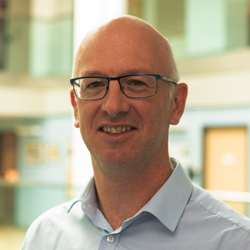
Prof Walter Kolch
Director, Systems Biology Ireland, University College Dublin

Prof Cormac Owens
Consultant Paediatric Oncologist, Children’s Health Ireland, Crumlin
Neuroblastoma represents only 6% of childhood cancers, yet accounts for 15% of cancer deaths in children. Some forms respond to treatment, while others are difficult to treat as they are resistant to anti-cancer drugs.
Current neuroblastoma treatments are often genotoxic, damaging the genome and causing severe side effects that can burden survivors for decades. How can we overcome drug resistance and improve treatments so there are fewer side effects?
Virtual representation
A team of clinicians, computer scientists and biologists at Children’s Health Ireland at Crumlin and UCD’s Systems Biology Ireland are trying a new approach. Funded by initiatives such as Precision Oncology Ireland and the Children’s Health Foundation, they are developing digital twins of neuroblastoma patients.
These are virtual models that allow the disease to be simulated on a computer so that diagnosis and treatment can be optimised on the model first before moving to the real patient. This makes the diagnosis more precise, and treatment can be tailored to individual patients ensuring that each patient gets the optimal treatment for their condition.
We are now expanding these digital twins to predict the response to chemotherapy for individual patients.
Personalised technology
Digital twin models have been successfully used by engineers for decades to design complicated machinery, such as cars and spacecraft. However, the complexity of the human body dwarfs the complexity of even the most sophisticated machines.
Building digital twins of human patients is a long-term endeavour that requires teamwork and cutting-edge technologies such as genome sequencing, gene expression and protein expression profiling.
We first construct molecular portraits of each patient. We then match these portraits with clinical features and encode them as algorithms which allow us to run the computer simulations. The first digital twin model produced by our researchers (Fey et al., 2015) could identify a group of high-risk neuroblastoma patients for whom we did not have reliable markers; and they could do this on a fully personalised basis predicting the exact risk of disease progression for each patient.
Enhancing treatment
We are now expanding these digital twins to predict the response to chemotherapy for individual patients. We are testing these models with cultured cancer cells in the laboratory and hope to make them available to assist doctors with treatment decisions within the next five years. The team is also using digital twins to discover entirely new drugs and drug targets that may replace genotoxic drugs altogether, thereby reducing long-term side effects. As developing a new drug takes around 15 years, this aim lies far in the future. However, the future has already started.
For more information, visit www.ucd.ie/sbi and childrenshealthireland.ie



